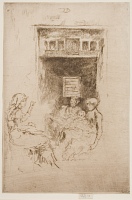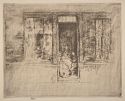Etchings Institutions search term: obach
Bead Stringers | ||
| Number: | 235 | |
| Date: | 1880 | |
| Medium: | etching and drypoint | |
| Size: | 229 x 154 mm | |
| Signed: | butterfly at left (8-final) | |
| Inscribed: | no | |
| Set/Publication: | 'Second Venice Set', 1886 | |
| No. of States: | 11 | |
| Known impressions: | 40 | |
| Catalogues: | K.198; M.195; W.164 | |
| Impressions taken from this plate (40) | ||
KEYWORD
TITLE
'Bead Stringers' (1883, F.A.S.). 1
'Bead-Stringers' (1886, Frederick Wedmore (1844-1921)). 2
The original title, 'Bead Stringers' is preferred.
1: London FAS 1883 (cat. no. 5).
2: Wedmore 1886 A (cat. no. 164).
DESCRIPTION
SITTER
SITE
3: Grieve 2000 , p. 132.
DISCUSSION


